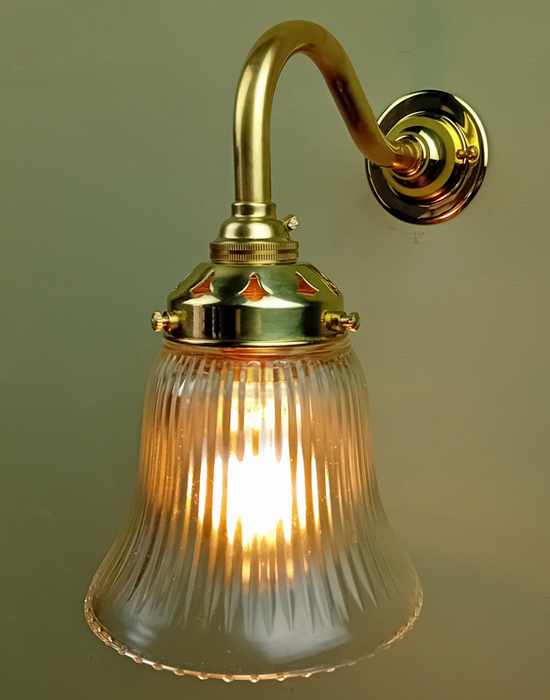




A very simple wall light based on a design supplied by Simplex from the 1880s, meticulously assembled by us using high-quality British and European-made components. The fixture is constructed from solid brass, available in finishes such as polished, acid-dipped antiqued, or nickel-plated. The prismatic tulip glass shade is the perfect complement, offering both elegance and function, casting a soft, diffused light that enhances the atmosphere of any room. As with all our products, every component is fully recyclable, ensuring a sustainable design.
The glass shades add character to both the lamp and the room. All are classic designs drawn from history, including simple bell shades that evoke the early days of candle lighting. Prismatic designs, once used by companies such as Holophane in gas lamps, became especially popular between the wars. Other designs here reflect the mid-century aesthetic with simple shapes and clean lines. All the glass shades are crafted in Britain, ensuring the highest standards of quality and craftsmanship.
Choose whether to mount the lamp in a traditional way on an oak backplate (or pateras) that you can wax and polish or paint as you wish, or mount the light without for a slightly more modern touch.
We recommend the use of modern LED bulbs and, if used, there is no restriction on its power. If old, filament (incandescent) bulbs are used then a maximum of 40w is recommended.
Prismatic Shades - 'Holophane'
During the early 1890s Andre Blondel, a French engineer and physicist, known for his work in electrical research and an attache to the Lighthouses and Beacons Service, and Spiridion Psaroudaki, a Greek engineer, conceived an idea in a Paris laboratory to cover a glass globe with horizontal glass prisms properly positioned to control light. Patents were awarded to the two inventors in Europe and, upon the granting of US Patent 563836 in 1893, an American, Otis A. Mygatt was introduced to this work. He saw the potential for both domestic and industrial lighting and began to collaborate with Blondel and Psaroudaki.
The advantages of prismatic shades very quickly became clear to a European public demanding brighter light. The prisms effectively focused the dim bulbs output to produce clear, bright, clean illumination and proved very popular in shops, schools, factories, lighthouses and homes. So much so that Mygatt bought the worldwide rights to Blondel and Psaroudaki's invention in 1894 and formed the Holophane Glass Company in 1898 in London to capitalise on his purchase. That same year Mygatt transferred the company to No.1 Broadway, New York.
The term 'Holophane' was derived from the Greek - 'Holos' and 'Phanein' - to contrive the meaning 'to appear completely luminous'. In 1900 Holophane was manufacturing a large range of globes and reflectors and described them thus: [they are made of] 'perfectly clear glass with prisms scientifically constructed in such a manner as to both direct the rays of light in downward and outward directions'.
Height: 23.5cm
Width: 12.5cm
Projection: 24.5cm